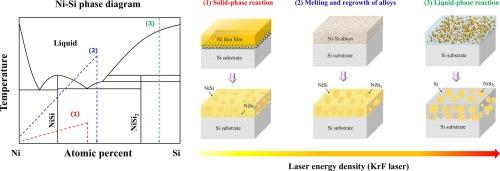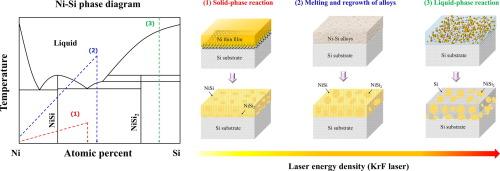紫外纳秒激光退火制备硅化镍薄膜的特性
IF 6.9
2区 材料科学
Q2 CHEMISTRY, PHYSICAL
引用次数: 0
摘要
基于紫外纳秒激光退火(UV-NLA)的硅化是一种很有前途的技术,可以在制造高度集成的互补金属氧化物半导体(CMOS)器件时减少热预算。本文基于KrF脉冲激光在Ni/p-Si衬底结构中施加的激光能量密度,研究了硅化镍形成的三种反应途径(固相反应(SPR)、固相反应后的熔融和再生以及液相反应(LPR))。随后,我们比较了硅化镍薄膜的表面粗糙度、晶体结构、界面质量、化学成分分布和电学性能。我们的结果证实了硅化镍薄膜的特性随硅化物形成机制的不同而变化。spr诱导膜呈现出NiSi和NiSi2混合多晶结构,界面平坦,成分沿界面分布均匀,不受硅化过程中熔融现象的影响。相比之下,lpr诱导的硅化镍薄膜表现出界面不稳定和由本构过冷引起的细胞结构。与spr诱导的多晶硅化镍膜相比,lpr诱导的多晶硅化镍膜的有效电子肖特基势垒高度(SBH)比spr诱导的低0.03 eV,这是由于重新构建了含有局部相干NiSi2的界面结构。我们的研究结果为通过UV-NLA实现硅化的综合方法提供了重要的见解,提出了一个有前途的下一代接触工艺。本文章由计算机程序翻译,如有差异,请以英文原文为准。


Characteristics of nickel silicide thin films fabricated by ultraviolet nanosecond laser annealing
Ultraviolet nanosecond laser annealing (UV-NLA)-based silicidation is a promising technology for reducing the thermal budget in the fabrication of highly integrated complementary metal–oxide–semiconductor (CMOS) devices. Here, we demonstrated three reaction pathways for nickel silicide formation (solid-phase reaction (SPR), melting and regrowth after SPR, and liquid-phase reaction (LPR)) based on the applied laser energy densities using KrF pulsed laser in a Ni/p-Si substrate structure. Subsequently, we compared the characteristics of the nickel silicide films including surface roughness, crystal structures, interfacial qualities, chemical composition distributions, and electrical properties. Our results confirmed that the characteristics of the nickel silicide films varied depending on the silicide formation mechanisms. SPR-induced films exhibited NiSi and NiSi2 mixed polycrystalline structures with flat interfaces and uniform composition distributed along the interfaces regardless of the melting phenomenon during silicidation. In contrast, LPR-induced nickel silicide films exhibited interfacial instabilities and cellular structures caused by constitutional supercooling. Compared with the SPR-induced polycrystalline nickel silicide films, the LPR-induced one exhibited an effective-electron Schottky barrier height (SBH) that was 0.03 eV lower due to the recreated interface structure containing locally coherent NiSi2. Our results provide crucial insights into implementing a comprehensive approach to silicidation through UV-NLA, presenting a promising next-generation contact process.
求助全文
通过发布文献求助,成功后即可免费获取论文全文。
去求助
来源期刊

Applied Surface Science
工程技术-材料科学:膜
CiteScore
12.50
自引率
7.50%
发文量
3393
审稿时长
67 days
期刊介绍:
Applied Surface Science covers topics contributing to a better understanding of surfaces, interfaces, nanostructures and their applications. The journal is concerned with scientific research on the atomic and molecular level of material properties determined with specific surface analytical techniques and/or computational methods, as well as the processing of such structures.
 求助内容:
求助内容: 应助结果提醒方式:
应助结果提醒方式:


